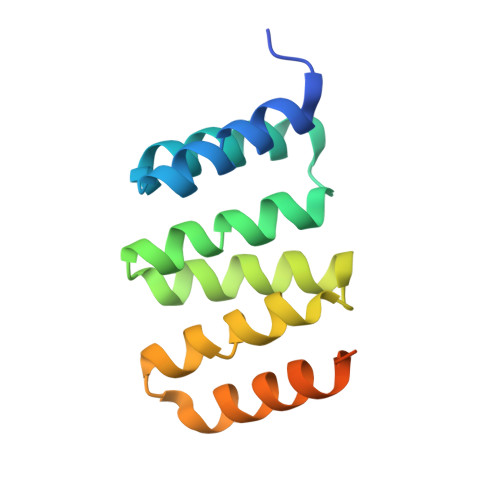Self-association of TPR domains: Lessons learned from a designed, consensus-based TPR oligomer.
Krachler, A.M., Sharma, A., Kleanthous, C.(2010) Proteins 78: 2131-2143
- PubMed: 20455268
- DOI: https://doi.org/10.1002/prot.22726
- Primary Citation of Related Structures:
2WQH - PubMed Abstract:
The tetratricopeptide repeat (TPR) motif is a protein-protein interaction module that acts as an organizing centre for complexes regulating a multitude of biological processes. Despite accumulating evidence for the formation of TPR oligomers as an additional level of regulation there is a lack of structural and solution data explaining TPR self-association. In the present work we characterize the trimeric TPR-containing protein YbgF, which is linked to the Tol system in Gram-negative bacteria. By subtracting previously identified TPR consensus residues required for stability of the fold from residues conserved across YbgF homologs, we identified residues involved in oligomerization of the C-terminal YbgF TPR domain. Crafting these residues, which are located in loop regions between TPR motifs, onto the monomeric consensus TPR protein CTPR3 induced the formation of oligomers. The crystal structure of this engineered oligomer shows an asymmetric trimer where stacking interactions between the introduced tyrosines and displacement of the C-terminal hydrophilic capping helix, present in most TPR domains, are key to oligomerization. Asymmetric trimerization of the YbgF TPR domain and CTPR3Y3 leads to the formation of higher order oligomers both in the crystal and in solution. However, such open-ended self-association does not occur in full-length YbgF suggesting that the protein's N-terminal coiled-coil domain restricts further oligomerization. This interpretation is borne out in experiments where the coiled-coil domain of YbgF was engineered onto the N-terminus of CTPR3Y3 and shown to block self-association beyond trimerization. Our study lays the foundations for understanding the structural basis for TPR domain self-association and how such self-association can be regulated in TPR domain-containing proteins.
Organizational Affiliation:
Department of Biology, University of York, Heslington, York YO10 5YW, United Kingdom.

















